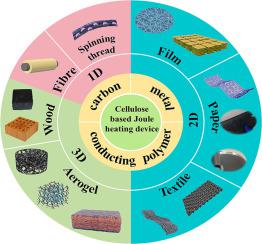当前位置:
X-MOL 学术
›
J. Mater. Sci. Technol.
›
论文详情
Our official English website, www.x-mol.net, welcomes your feedback! (Note: you will need to create a separate account there.)
Recent advances in multidimensional (1D, 2D, and 3D) Joule heating devices based on cellulose: Design, structure, application, and perspective
Journal of Materials Science & Technology ( IF 11.2 ) Pub Date : 2024-04-24 , DOI: 10.1016/j.jmst.2024.04.015 Chuanyin Xiong , Mengjie Zhao , Tianxu Wang , Jing Han , Yongkang Zhang , Zhao Zhang , Xianglin Ji , Qing Xiong , Yonghao Ni
Journal of Materials Science & Technology ( IF 11.2 ) Pub Date : 2024-04-24 , DOI: 10.1016/j.jmst.2024.04.015 Chuanyin Xiong , Mengjie Zhao , Tianxu Wang , Jing Han , Yongkang Zhang , Zhao Zhang , Xianglin Ji , Qing Xiong , Yonghao Ni

|
The demand for flexible electric heating devices has increased due to technology advancement and improved living standards. These devices have various applications including personal thermal management, hyperthermia, defrosting, agricultural heating film, and oil-water separation. Joule heat, generated by electric currents, is commonly used in electrical appliances. To incorporate Joule heating into flexible electronics, new materials with excellent mechanical properties are necessary. Traditional polymers, used as reinforcements, limit the continuity of conductive networks in composites. Therefore, there is a need to develop flexible Joule thermal composite materials with enhanced mechanical strength and conductivity. Cellulose, a widely available renewable resource, is attracting attention for its excellent mechanical properties. It can be used as a dispersant and reinforcing agent for conductive fillers in cellulose-based composites, creating highly conductive networks. Various forms of cellulose, such as wood, nanocellulose, pulp fiber, bacterial cellulose, cellulose paper, textile clothing, and aramid fiber, have been utilized to achieve high-performance Joule thermal composites. Researchers have achieved excellent mechanical properties and developed efficient electric heating devices by designing cellulose-based composites with different structures. The scalable production methods enable large-scale application of cellulose-based devices, each with unique advantages in 1D, 2D, and 3D structures. This review summarizes recent advancements in cellulose-based Joule thermal composites, providing insights into different structural devices, and discussing prospects and challenges in the field.
中文翻译:

基于纤维素的多维(1D、2D 和 3D)焦耳加热装置的最新进展:设计、结构、应用和前景
由于技术进步和生活水平的提高,对柔性电加热设备的需求不断增加。这些设备具有多种应用,包括个人热管理、热疗、除霜、农业加热膜和油水分离。由电流产生的焦耳热通常用于电器中。为了将焦耳热融入柔性电子产品中,需要具有优异机械性能的新材料。用作增强材料的传统聚合物限制了复合材料中导电网络的连续性。因此,需要开发具有增强机械强度和导电性的柔性焦耳热复合材料。纤维素是一种广泛使用的可再生资源,因其优异的机械性能而受到关注。它可用作纤维素基复合材料中导电填料的分散剂和增强剂,形成高导电网络。各种形式的纤维素,如木材、纳米纤维素、纸浆纤维、细菌纤维素、纤维素纸、纺织服装和芳纶纤维,已被用来实现高性能焦耳热复合材料。研究人员通过设计不同结构的纤维素基复合材料,获得了优异的机械性能,并开发出高效的电加热装置。可扩展的生产方法使得纤维素基器件的大规模应用成为可能,每种器件在 1D、2D 和 3D 结构方面都具有独特的优势。这篇综述总结了基于纤维素的焦耳热复合材料的最新进展,提供了对不同结构装置的见解,并讨论了该领域的前景和挑战。
更新日期:2024-04-24
中文翻译:

基于纤维素的多维(1D、2D 和 3D)焦耳加热装置的最新进展:设计、结构、应用和前景
由于技术进步和生活水平的提高,对柔性电加热设备的需求不断增加。这些设备具有多种应用,包括个人热管理、热疗、除霜、农业加热膜和油水分离。由电流产生的焦耳热通常用于电器中。为了将焦耳热融入柔性电子产品中,需要具有优异机械性能的新材料。用作增强材料的传统聚合物限制了复合材料中导电网络的连续性。因此,需要开发具有增强机械强度和导电性的柔性焦耳热复合材料。纤维素是一种广泛使用的可再生资源,因其优异的机械性能而受到关注。它可用作纤维素基复合材料中导电填料的分散剂和增强剂,形成高导电网络。各种形式的纤维素,如木材、纳米纤维素、纸浆纤维、细菌纤维素、纤维素纸、纺织服装和芳纶纤维,已被用来实现高性能焦耳热复合材料。研究人员通过设计不同结构的纤维素基复合材料,获得了优异的机械性能,并开发出高效的电加热装置。可扩展的生产方法使得纤维素基器件的大规模应用成为可能,每种器件在 1D、2D 和 3D 结构方面都具有独特的优势。这篇综述总结了基于纤维素的焦耳热复合材料的最新进展,提供了对不同结构装置的见解,并讨论了该领域的前景和挑战。







































 京公网安备 11010802027423号
京公网安备 11010802027423号